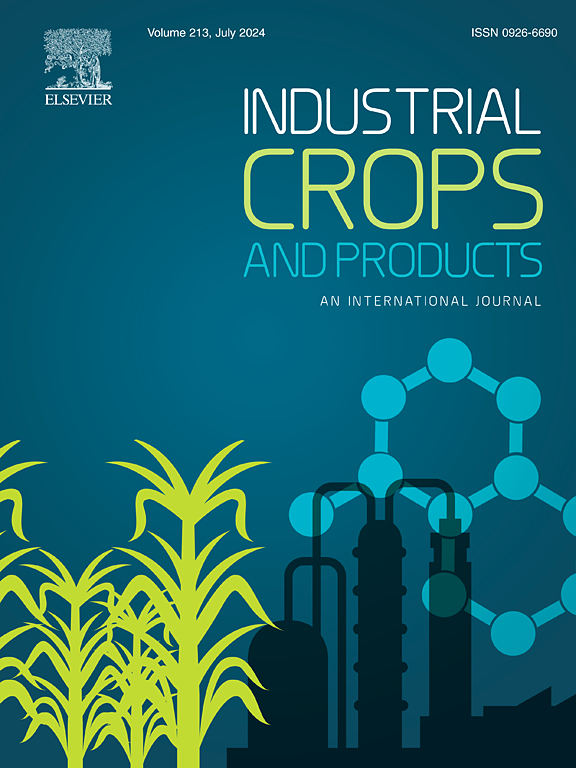Development and characterization of Polylactic acid-Polyhydroxybutyrate (PLA-PHB) blend impregnated with mango extracts for use as active film
IF 5.6
1区 农林科学
Q1 AGRICULTURAL ENGINEERING
引用次数: 0
Abstract
The study examined the impregnation of Polylactic acid-Polyhydroxybutyrate (PLA-PHB) (75:25 w/w) polymer films with mango leaf extracts (MLE) using solvent casting and a supercritical solvent impregnation process. The effects of pressure, temperature, and depressurization rate on the impregnation and release of bioactive compounds were evaluated. The impregnated and non-impregnated samples were analysed by Fourier Transform Infrared Spectroscopy (FTIR), Thermogravimetric analysis (TGA), Differential Scanning Calorimetry (DSC), X-ray diffraction (XRD), and Scanning Electron Microscopy (SEM) to determine their impregnation load, antioxidant capacity, and compound release after 10 days. The FTIR analyses showed that the samples impregnated at 20 MPa exhibited a more intense peak compared to those impregnated at 10 and 30 MPa, indicating higher impregnation loads and antioxidant compound concentration. Thermal studies (TGA and DSC) demonstrated that impregnation did not significantly affect the thermal stability of the material. In X-rays patterns, the promotion of PHB crystallization on top of the amorphous PLA halo was observed at high depressurization rates. Furthermore, SEM images revealed changes in the surface morphology after impregnation. The highest impregnation load was obtained at 20 MPa, 35 °C, and 5 MPa/min (3.39 ± 0.03 mg MLE/100 mg PLA-PHB), while the concentration of antioxidant compounds (IAC) was highest at 20 MPa and 55 °C with slow depressurization (2.72 ± 0.02 mg IAC / 100 mg PLA-PHB). Gallic acid and iriflofenone 3-C-β-D-glucoside were the main released compounds.

用芒果提取物浸渍聚乳酸-聚羟基丁酸酯(PLA-PHB)共混物作为活性膜的研制与表征
研究了芒果叶提取物(MLE)对聚乳酸-聚羟基丁酸酯(PLA-PHB) (75:25 w/w)聚合物薄膜的溶剂铸造和超临界溶剂浸渍工艺。考察了压力、温度和减压速率对生物活性化合物浸渍和释放的影响。采用傅里叶变换红外光谱(FTIR)、热重分析(TGA)、差示扫描量热法(DSC)、x射线衍射(XRD)和扫描电镜(SEM)对浸渍和未浸渍样品进行分析,测定其浸渍负荷、抗氧化能力和10 d后化合物释放量。FTIR分析表明,与10和30 MPa浸渍的样品相比,20 MPa浸渍的样品表现出更强的峰值,表明浸渍负荷和抗氧化化合物浓度更高。热分析(TGA和DSC)表明,浸渍对材料的热稳定性没有显著影响。在x射线图中,在高减压速率下观察到PHB在非晶态PLA晕上的结晶促进。此外,SEM图像显示了浸渍后表面形貌的变化。最高的浸渍负载得到20 MPa, 35°C和5 MPa /分钟(3.39 ±0.03 大中型企业的/ 100毫克 毫克PLA-PHB),而抗氧化化合物的浓度(IAC)最高20 MPa和55°C缓慢降压(2.72 ±0.02 mg IAC / 100 毫克PLA-PHB)。未食子酸和伊氟芬酮3-C-β- d -葡萄糖苷是主要的释放化合物。
本文章由计算机程序翻译,如有差异,请以英文原文为准。
求助全文
约1分钟内获得全文
求助全文
来源期刊

Industrial Crops and Products
农林科学-农业工程
CiteScore
9.50
自引率
8.50%
发文量
1518
审稿时长
43 days
期刊介绍:
Industrial Crops and Products is an International Journal publishing academic and industrial research on industrial (defined as non-food/non-feed) crops and products. Papers concern both crop-oriented and bio-based materials from crops-oriented research, and should be of interest to an international audience, hypothesis driven, and where comparisons are made statistics performed.
 求助内容:
求助内容: 应助结果提醒方式:
应助结果提醒方式:


